
Kawagoe Castle was built in Musashi Province in 1457. It was constructed by Ota Doshin and his son Ota Dokan on the orders of their suzerain, Uesugi Mototomo of the Ogigayatsu branch of the Uesugi clan. Later, the castle passed into the possession of another branch of the same clan, the Yamanouchi.
The Rise of the Hojo Clan
The son of the founder of the Hojo clan, Hojo Ujitsuna, continued his father's work of expanding the clan's influence in the Kanto region.
In 1524, he attacked Edo Castle, and in 1537, he captured Kawagoe. From that moment on, the castle became a key outpost on the border between the Hojo and Uesugi domains. Ujitsuna died in 1541.
The Uesugi Alliance Against the Hojo
Three years later, in 1544, Uesugi Tomosada of the Ogigayatsu branch and Uesugi Norimasa of the Yamanouchi branch joined forces to counter the expansion of the Hojo clan. They enlisted the support of Ashikaga Haruuji, who held the position of official representative of the shogun in the Kanto region.
Although Haruuji was Ujitsuna's son-in-law and had previously been allied with Hojo, he decided to side with Uesugi.
The beginning of the siege of Kawagoe
In the autumn of 1545, the combined forces of Tomosada, Norimasa, and Haruuji invaded the Hojo lands and laid siege to Kawagoe Castle.
The allies reasonably expected that the new daimyo of the Hojo clan — Hojo Ujiyasu (1515–1571) — would be unable to send reinforcements to the castle, as at the same time the troops of the Takeda and Imagawa clans invaded Sagami Province from the west and threatened the Hojo stronghold — Odawara Castle.
The garrison and enemy forces
Since 1537, the commander of Kawagoe Castle had been Hojo Tsunasige, the adopted son of Ujitsuna and, accordingly, the half-brother of Ujiyasu. He commanded about three thousand soldiers.
According to some sources, the besieging forces numbered up to 80,000 men, but most historians consider this figure to be greatly exaggerated.
Fortifications of the castle
At the time of the siege, Kawagoe was a flatland castle (hirajiro) with a developed system of fortifications. It included six courtyards separated from each other by moats, earthen ramparts, and clay walls on top. The passages were covered by powerful gates, and watchtowers were located around the perimeter. Some external exits were additionally reinforced with umadashi barbicans.
The besiegers' tactics
Several attempts to storm the castle failed, and the allies resorted to a blockade tactic, hoping to wear down the fortress. By the spring of 1546, after lengthy negotiations, Hojo Ujiasu managed to make peace with Imagawa and focus his attention on Kawagoe.
Since a political solution could not be reached, Ujiasu sent troops to rescue the fortress garrison. The relief army numbered only 8,000 soldiers, significantly fewer than the besiegers.
Reconnaissance and attack plan
This is where Ujiasu's talent as a commander and his ability to use shinobi scouts came into play. According to intelligence reports, the allied forces had lost their vigilance during the many months of siege and were not expecting an attack; the garrison was not being properly maintained.
A risky plan for a night attack was developed. Agents were sent to the castle to warn the garrison about reinforcements and plans for a relief strike in order to coordinate actions.
Ujisasa ordered his soldiers not to wear heavy armor and not to be distracted by collecting enemy heads, so as not to slow down the pace of the attack. This order did not sit well with the soldiers, as the number of heads collected was a measure of valor. However, Hojo's vassals did not dare to disobey.
Night attack and defeat of the allies
At night, Ujisuke's warriors launched an attack and were immediately supported by a sortie from the castle defenders. Uesugi's troops were caught off guard. Panic ensued, and the soldiers were put to flight. One of the commanders of the besiegers, Uesugi Tomosada, was killed in the battle.
This brilliant operation brought Hojo Ujiyasu fame as a great warrior. None of the representatives of the Hojo clan ever achieved such success again.
See also
-
The Siege of Hara Castle

The Shimabara Rebellion of 1637–1638, which culminated in the siege of Hara Castle, was the last major uprising of the Edo period and had serious political consequences.
-
Battle of Tennoji

The confrontation between Tokugawa Ieyasu and Toyotomi Hideyori during the “Osaka Winter Campaign” ended with the signing of a peace treaty. On January 22, 1615, the day after the treaty was signed, Ieyasu pretended to disband his army. In reality, this meant that the Shimazu forces withdrew to the nearest port. On the same day, almost the entire Tokugawa army began filling in the outer moat.
-
Siege of Shuri Castle

The Ryukyu Kingdom was established in 1429 on Okinawa, the largest island of the Ryukyu (Nansei) archipelago, as a result of the military unification of three rival kingdoms. In the following years, the state's control spread to all the islands of the archipelago.
-
The Siege of Fushimi Castle
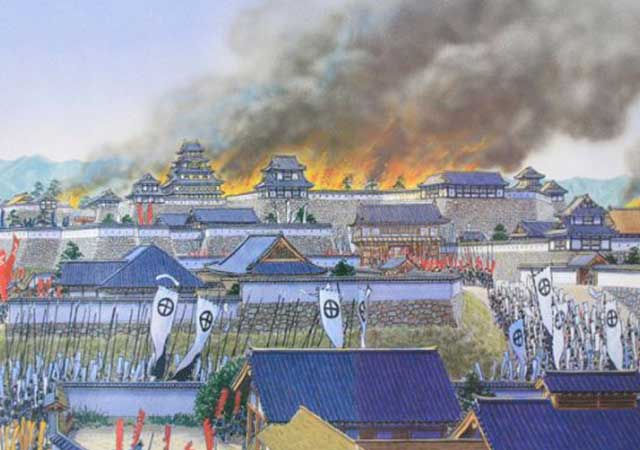
Fushimi can perhaps be considered one of the most “unfortunate” castles of the Sengoku Jidai period. The original castle was built by Toyotomi Hideyoshi in the southeast of Kyoto in 1594 as his residence in the imperial city.
-
The Siege of Otsu Castle
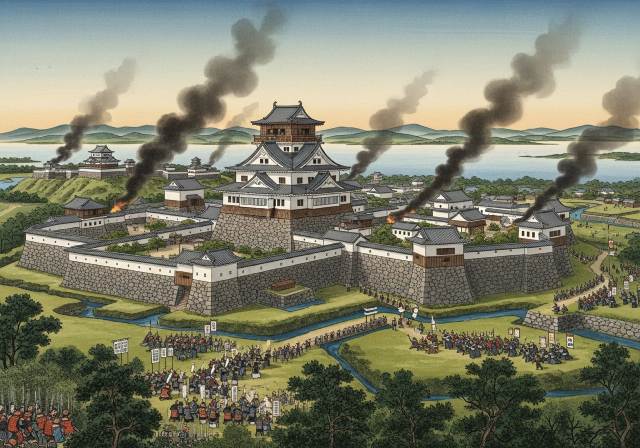
The siege of Otsu Castle was part of the Sekigahara campaign, during which the so-called Eastern Coalition, led by Tokugawa Ieyasu, fought against the Western Coalition, led by Ishida Mitsunari. Otsu Castle was built in 1586 by order of Toyotomi Hideyoshi near the capital Kyoto, on the site of the dismantled Sakamoto Castle. It belonged to the type of “water castles” — mizujō — as one side of it faced Japan's largest lake, Lake Biwa, and it was surrounded by a system of moats filled with lake water, which made the fortress resemble an island.
-
The Siege of Shiroishi Castle
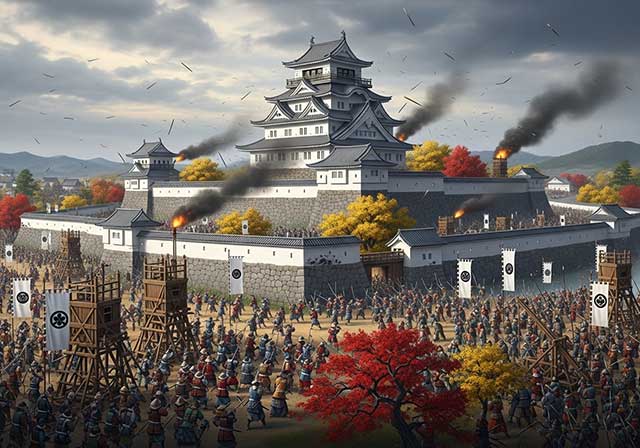
The siege of Shiroishi Castle was part of the Sekigahara campaign and took place several months before the decisive battle of Sekigahara. The daimyo of Aizu Province, Uesugi Kagekatsu, posed a serious threat to Tokugawa Ieyasu's plans to defeat the Western Coalition, and Ieyasu decided to curb his actions with the help of his northern vassals. To this end, he ordered Date Masamune to invade the province of Aizu and capture Shiroishi Castle.
-
The Second Siege of Jinju Castle
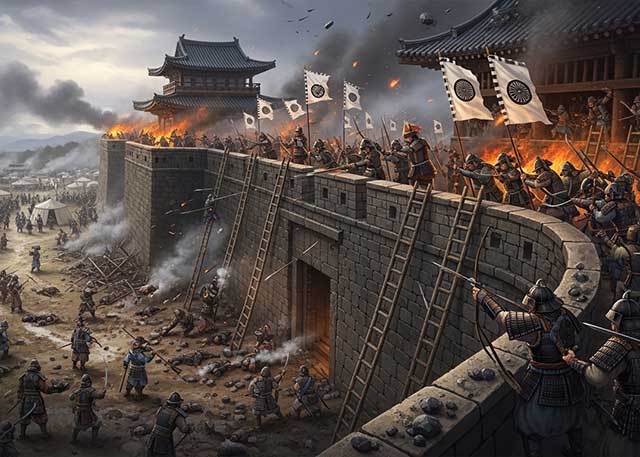
During the two Korean campaigns of the 16th century, the Japanese repeatedly had to capture enemy fortresses and defend occupied or constructed fortifications from the combined Korean and Chinese forces. Among all the operations of that time, the second siege of Jinju Castle is considered the most interesting from the point of view of siege warfare.
-
The Siege of Takamatsu Castle
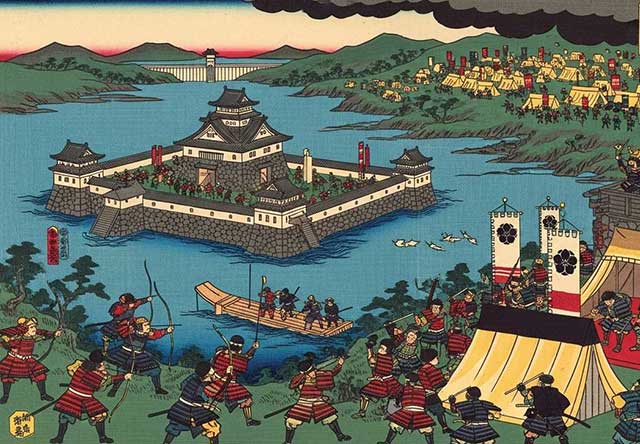
The siege of Takamatsu Castle in Bitchu Province is considered the first mizuzeme, or “water siege,” in Japanese history. Until then, such an original tactic had never been used.

